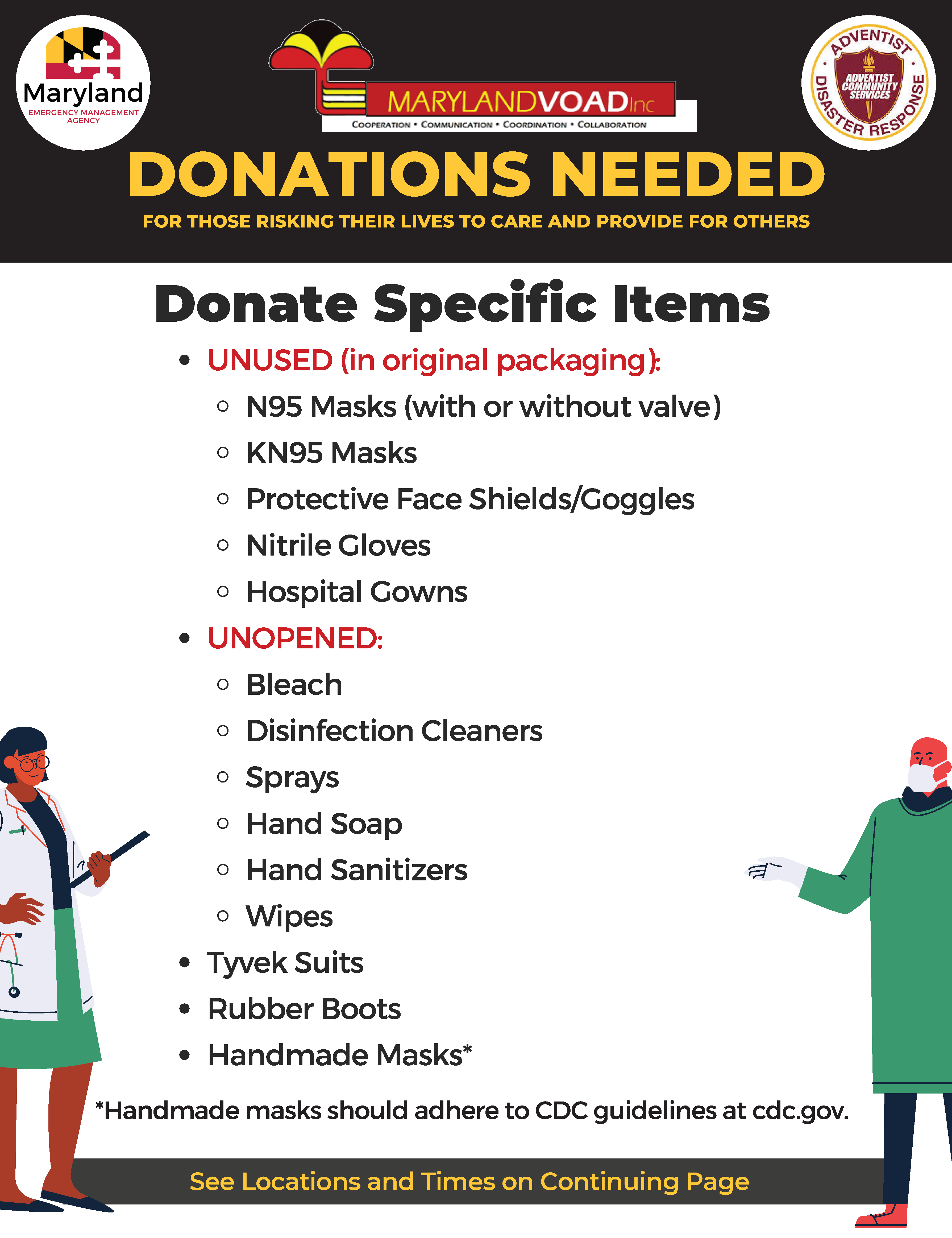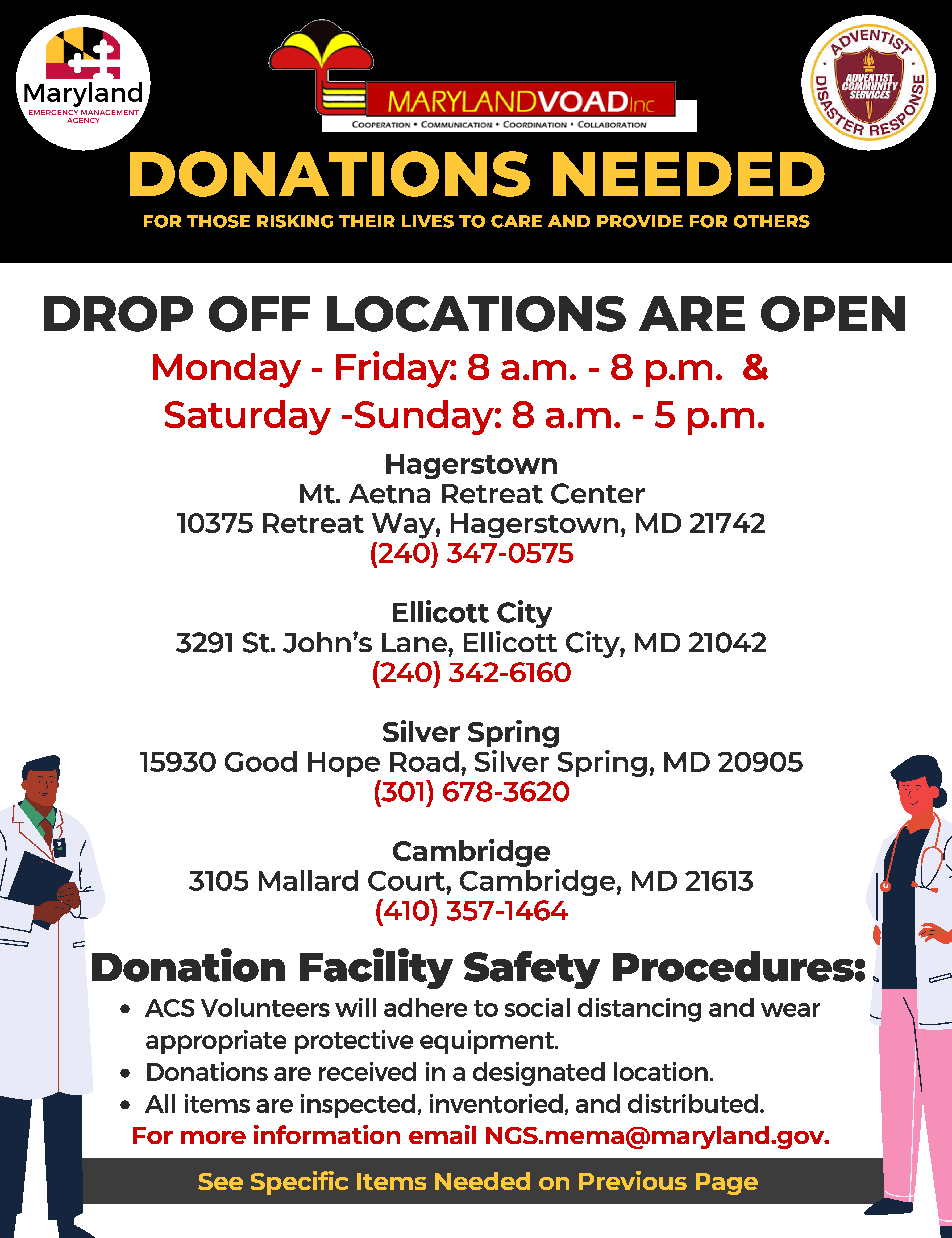Donation and Volunteer Opportunities
Find donation and/or volunteer opportunities to serve fellow Marylanders listed below. Please adhere to all safety protocols for each organization. For local volunteer opportunities, visit “Volunteering in Maryland.”
Governor Larry Hogan announced that Maryland has activated the Maryland Responds Medical Reserve Corps, a force of dedicated and trained medical volunteers who are ready to assist in a public health emergency. We are urging Marylanders to sign up at mdresponds.health.maryland.gov.
For more information, visit mdresponds.health.maryland.gov


Maryland Volunteer Organizations Active in Disasters (VOAD) and the Adventist Community Services (ACS) have partnered to coordinate the collection and dissemination of these vital supplies. These efforts are in support of the Maryland Emergency Management Agency and other state agencies to provide drop-off sites for medical, cleaning supplies donations.
“I would like to thank the voluntary organizations active in disaster for assisting Marylanders in this time of need,” said MEMA Executive Director Russ Strickland. “This network of donations centers allows the community to help those on the front lines of fighting this virus. We could not respond to the challenges of COVID-19 without a whole of community effort.”
Donate Specific Items:
- UNUSED (in original packaging):
- N95 Masks (with or without valve)
- KN95 Masks
- Protective Face Shields/Goggles
- Nitrile Gloves
- Hospital Gown
- UNOPENED:
- Bleach
- Disinfection Cleaners
- Sprays
- Hand Soap
- Hand Sanitizers
- Wipes
- Tyvek Suits
- Rubber Boots
- Handmade Masks*
*Handmade masks should adhere to CDC guidelines at cdc. gov.
Cash, food, and donations not on the list of specific items WILL NOT be accepted at these locations. Marylanders are encouraged to send other donations to local nonprofits and churches.
Drop off locations are open:
- Monday through Friday: 8 a.m. – 8 p.m.
- Saturday and Sunday: 8 a.m. – 5 p.m.
The four donation drop off locations in Maryland are:
- Ellicott City: 3291 St. John‘s Lane, Ellicott City, Md.. 21042
- (240) 342-6160
- Cambridge: 3105 Mallard Court., Cambridge, Md. 21613
- (410) 357-1464
- Visible from Rt. 50. Drop off in the parking circle.
- Hagerstown: 10375 Retreat Way, Hagerstown, MD 21742
- Mt. Aetna Retreat Center
- (240) 347-0575
- May also be listed on GPS as 21905 Mt. Aetna Road
- Silver Spring: 15930 Good Hope Road, Silver Spring, MD 20905
- (301) 678-3620
- Corner of Route 198 and Good Hope Road. Entrance right off of Good Hope Road, lower parking lot.
Donation Facility Safety Procedures:
- ACS Volunteers will adhere to social distancing and wear appropriate protective equipment.
- Donations are received in a designated location.
- All items are inspected, inventoried, and distributed.
For more information email ngs.mema@maryland.gov. Visit here for a shareable link featuring the flyers in English and Spanish with image descriptions.
The American Red Cross now faces a severe blood shortage. Healthy individuals are needed to donate now to help patients counting on lifesaving blood.
For more information, visit here.
The Maryland Food Bank is working to ensure there is an adequate supply of food available at pantries and community organizations across the state for the remainder of this public health crisis. To meet this need, the Maryland Food Bank desperately needs help packing “Back Up Boxes” containing 30 pounds of shelf-stable, nutritious foods.
Can you help? If so, go here to sign-up as an individual. Or even better, go here to organize a group of volunteers.
Read the full letter by Thomas Higdon, the Volunteer Program Manager of the Maryland Food Bank for more safety information: Maryland Food Bank Call for Volunteers.
For more information, visit mdfoodbank.org.
As schools close to prevent the spread of COVID-19, the State of Maryland is working to ensure that students have all the meals they need. No Kid Hungry is providing additional support nationwide.
For more information, visit here.
Thank you for reaching out to respond to the shortage of PPE. The best way you can meet this critical need is by reaching out to your local volunteer connector or disaster management services directly.
Handmade donations can also be accepted by the Maryland Emergency Management Agency. Learn more above “2. Maryland Emergency Management Agency (MEMA) – Donate Supplies”.
Spotlight: Click to see an example of how Anne Arundel Medical Center is engaging volunteers, and ensuring the safety and protection of those who volunteer and those who use the PPE with step-by-step instructions. Click to see the Center for Disease Control’s DIY cloth face covering instructions.
Please keep in mind an influx of unexpected or unnecessary volunteers and donations can make the process even more difficult. Learn where and when your skills will be needed from your local volunteer connector, DO NOT self-deploy. Discuss with volunteer organizers how your safety, and those you serve, will be met.
Register for volunteer opportunities with the Disaster Aid Response Team (DART), here.
Donate and serve wisely to help disaster victims. Visit the Maryland Voluntary Organizations Active in Disaster (VOAD) for a list of private and nonprofit agencies active in disaster relief, here.
The State of Maryland encourages everyone to contribute wisely to disaster recovery efforts. Consider the following before you donate goods, money, or your time:
- Financial contributions are preferred.
- Cash donations help to avoid the labor and expense of sorting, packing, transporting, and distributing donated goods, and voluntary relief agencies use cash to meet victims’ specific needs more quickly.
- Relief agencies prefer the versatility of cash donations; however, some have the infrastructure in place to store and distribute donated goods. To prevent waste, donations of goods should be made only to agencies that have requested specific items.
- Donors should be wary of anyone who claims that “everything” is needed. Many groups have been disappointed that their efforts and the goods they collected were not appreciated. A community hit by disaster, however, does not have the time, manpower, or money to dispose of unneeded donations. Get precise information before collecting any donated goods.
- In a community struggling to respond to and recover from a disaster, an influx of unexpected or unneeded volunteers and donations can make the process even more difficult. Before traveling to the disaster area to help, learn where and when your skills will be needed from your local volunteer connector. Discuss with volunteer organizers how your needs for food, water, and shelter will be met while you are volunteering.
This guideline is not for individuals, but for organizations.
Volunteering for Essential Services IS allowed to continue under Governor Hogan’s Stay-at-Home Order, as specific exclusions include “any non-profit organization or facility providing essential services to low income persons, including, without limitation, homeless shelters, food banks, and soup kitchens.“ More information, here.

